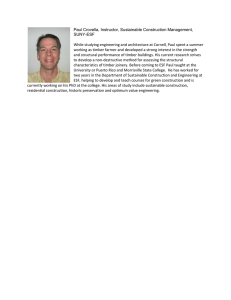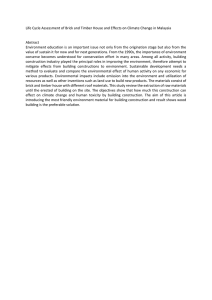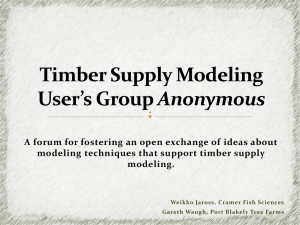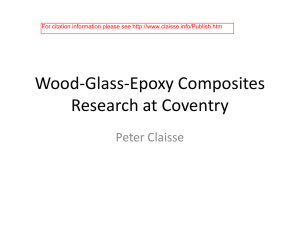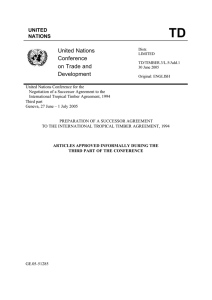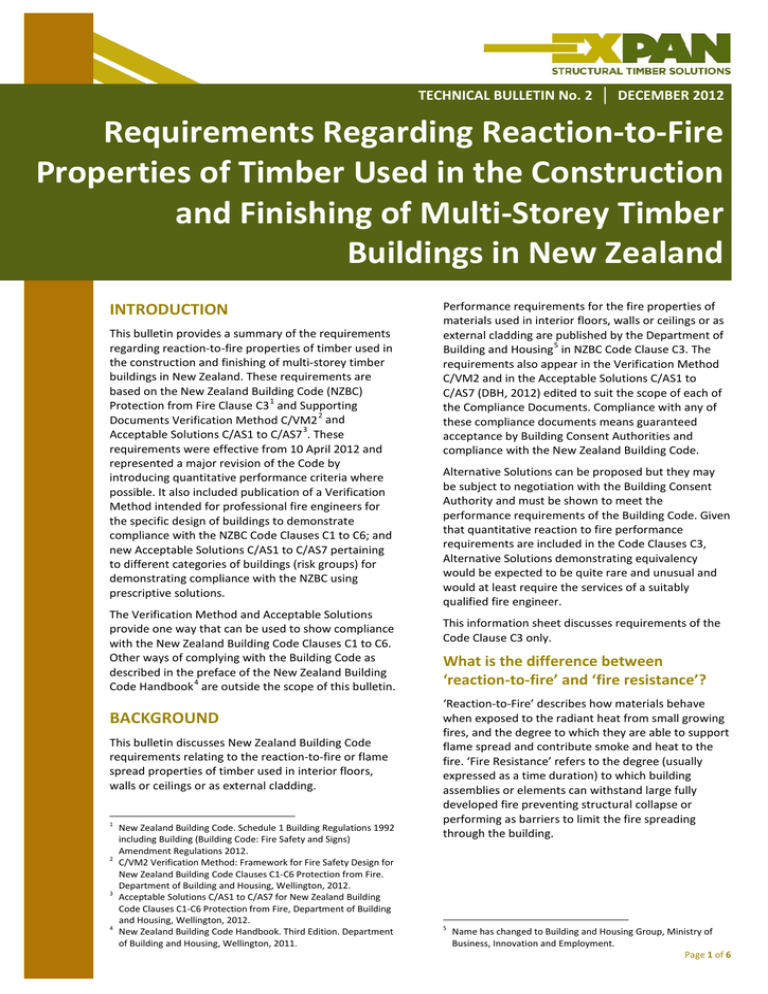
TECHNICAL BULLETIN No. 2 │ DECEMBER 2012
Requirements Regarding Reaction-to-Fire
Properties of Timber Used in the Construction
and Finishing of Multi-Storey Timber
Buildings in New Zealand
INTRODUCTION
This bulletin provides a summary of the requirements
regarding reaction-to-fire properties of timber used in
the construction and finishing of multi-storey timber
buildings in New Zealand. These requirements are
based on the New Zealand Building Code (NZBC)
1
Protection from Fire Clause C3 and Supporting
2
Documents Verification Method C/VM2 and
3
Acceptable Solutions C/AS1 to C/AS7 . These
requirements were effective from 10 April 2012 and
represented a major revision of the Code by
introducing quantitative performance criteria where
possible. It also included publication of a Verification
Method intended for professional fire engineers for
the specific design of buildings to demonstrate
compliance with the NZBC Code Clauses C1 to C6; and
new Acceptable Solutions C/AS1 to C/AS7 pertaining
to different categories of buildings (risk groups) for
demonstrating compliance with the NZBC using
prescriptive solutions.
The Verification Method and Acceptable Solutions
provide one way that can be used to show compliance
with the New Zealand Building Code Clauses C1 to C6.
Other ways of complying with the Building Code as
described in the preface of the New Zealand Building
4
Code Handbook are outside the scope of this bulletin.
BACKGROUND
This bulletin discusses New Zealand Building Code
requirements relating to the reaction-to-fire or flame
spread properties of timber used in interior floors,
walls or ceilings or as external cladding.
1
2
3
4
New Zealand Building Code. Schedule 1 Building Regulations 1992
including Building (Building Code: Fire Safety and Signs)
Amendment Regulations 2012.
C/VM2 Verification Method: Framework for Fire Safety Design for
New Zealand Building Code Clauses C1-C6 Protection from Fire.
Department of Building and Housing, Wellington, 2012.
Acceptable Solutions C/AS1 to C/AS7 for New Zealand Building
Code Clauses C1-C6 Protection from Fire, Department of Building
and Housing, Wellington, 2012.
New Zealand Building Code Handbook. Third Edition. Department
of Building and Housing, Wellington, 2011.
Performance requirements for the fire properties of
materials used in interior floors, walls or ceilings or as
external cladding are published by the Department of
5
Building and Housing in NZBC Code Clause C3. The
requirements also appear in the Verification Method
C/VM2 and in the Acceptable Solutions C/AS1 to
C/AS7 (DBH, 2012) edited to suit the scope of each of
the Compliance Documents. Compliance with any of
these compliance documents means guaranteed
acceptance by Building Consent Authorities and
compliance with the New Zealand Building Code.
Alternative Solutions can be proposed but they may
be subject to negotiation with the Building Consent
Authority and must be shown to meet the
performance requirements of the Building Code. Given
that quantitative reaction to fire performance
requirements are included in the Code Clauses C3,
Alternative Solutions demonstrating equivalency
would be expected to be quite rare and unusual and
would at least require the services of a suitably
qualified fire engineer.
This information sheet discusses requirements of the
Code Clause C3 only.
What is the difference between
‘reaction-to-fire’ and ‘fire resistance’?
‘Reaction-to-Fire’ describes how materials behave
when exposed to the radiant heat from small growing
fires, and the degree to which they are able to support
flame spread and contribute smoke and heat to the
fire. ‘Fire Resistance’ refers to the degree (usually
expressed as a time duration) to which building
assemblies or elements can withstand large fully
developed fire preventing structural collapse or
performing as barriers to limit the fire spreading
through the building.
5
Name has changed to Building and Housing Group, Ministry of
Business, Innovation and Employment.
Page 1 of 6
INTERIOR WALLS AND CEILINGS
What about smoke production?
What are Group Numbers?
In some locations in buildings not protected with an
automatic fire sprinkler system, the NZBC Clause C3.4
requires, in addition to a Group Number classification,
the rate of smoke production to be less than
2
2
250 m /kg in the ISO 5660 test or less than 5 m /s in
the ISO 9705 test. When these limits are required to
be met the Group Number is appended with a ‘-S’. (eg,
Group Number 1-S).
Group Numbers are derived from testing to either ISO
5660 (cone calorimeter test) or ISO 9705 (room-corner
test) and are used in NZBC Code Clause C3.4 to control
the reaction-to-fire properties of interior wall and
ceiling linings. The detailed procedure for determining
the Group Number using fire test data is given in
C/VM2 Appendix A. Group Numbers are measured on
a scale of 1 (good) to 4 (bad). A Group Number of 4 is
indicative of rapid flame spread potential and is not
permitted in areas of buildings subject to reaction to
fire controls.
Why are there two test methods for
determining Group Numbers?
The Group Number is associated with the time to
flashover in a small room (ie, total fire involvement
with everything burning). Time to flashover is a good
measure of the fire hazard since the longer it takes for
this to occur the more time available for occupants to
escape from the building. The ISO 9705 test measures
this time directly because it is a full-scale fire test in a
room where the walls and ceiling are lined with the
product to be evaluated.
In the ISO 9705 test, time to flashover (TFO) is taken as
the time at which the measured rate of heat release
reaches 1 MW, and is related to the Group Number as
follows:
TFO < 2 min
2 ≤ TFO < 10 min
10 ≤ TFO < 20 min
No flashover in 20 min
(Group Number 4)
(Group Number 3)
(Group Number 2)
(Group Number 1)
However, since the ISO 9705 test requires a large
amount of test material and is expensive to carry out,
there is an alternative fire test ISO 5660 which
requires only small samples of the test product
measuring 100 × 100 mm in area. Burning rate data
from the ISO 5660 test is used in a calculation that
predicts the Group Number. This is a less expensive
and more convenient means of obtaining a Group
Number. In most, but not necessarily all cases, the
Group Number assignment obtained from each test
will be the same. Where there is a difference usually
the Group Number is more conservative (higher) using
ISO 5660 compared to ISO 9705.
Group Numbers of timber depend on the species,
density and thickness of the material. In New Zealand,
materials must be tested with any applied coatings or
finishes included. Group Numbers of timber may be
improved with the use of fire-retardant treatments or
coatings.
In any location where NZBC Clause C3.4 permits a
Group Number 3, or in any location in a building
protected with an automatic fire sprinkler system,
there are no limits placed on the smoke production
rate.
What are typical Group Numbers and
smoke production rates achieved by
timber surfaces?
Untreated, unfinished timber typically achieves a
Group Number of 3, depending on species and
thickness of the wood. However, it is possible that
some high density timbers may achieve a lesser value,
whereas some very low density timbers may be
higher. Therefore the relevant technical data should
be requested from the manufacturer or supplier of the
product.
Smoke production rates for exposed timber are
2
typically less than 250 m /kg in the ISO 5660 test and
2
less than 5 m /s in the ISO 9705 test. Both the Group
Number and smoke production rate can change when
coatings are applied to the surface of the timber. For
compliance with the NZBC, the Group Numbers and
smoke production rates must be supported by fire test
results. These should be requested from the
manufacturer or supplier of the product or coating.
Can I use timber products for surface
linings within individual household units
of residential buildings?
Yes, the NZBC Clause 3.4 allows wood products to be
used anywhere within household units in detached
dwellings (eg, houses) and also within household units
in residential flats or apartment buildings. The
household units may be single level or multi-level and
Group Numbers for wood products are not required.
However, this exemption does not include any exit
stairs or corridors in these buildings that are used by
more than one household unit.
Page 2 of 6
Are there any parts of buildings that are
exempt from meeting the reaction-tofire requirements?
Yes, handrails and general decorative trim (ie,
architraves, skirting, window reveals, etc) are exempt
from reaction-to-fire requirements. In addition, small
areas of non-conforming product within a space with a
2
total aggregate surface area of not more than 5.0 m
are permitted.
Also exempt are individual doorsets and continuous
areas of permanently installed openable wall
partitions not more than 3 m high and having a
surface area not more than 25% of the divided room
2
floor area or 5 m (whichever is less).
Also included are all occupied spaces in buildings
designated an Importance Level of 4.
In these locations the Group Number shall be no
greater than 1-S if un-sprinklered, or 2 if
sprinklered. Wood products as wall or ceilings
could typically only be used in these locations if
fire retardant treatments have been applied and
the relevant fire test data is available to
demonstrate compliance.
2.
Timber joinery and structural timber building elements
(such as heavy timber columns, beams, portals and
shear walls not more than 3 m wide) constructed from
solid wood, glulam or laminated veneer lumber are
exempt from reaction-to-fire requirements. These
elements may still be required to achieve certain fire
resistance ratings so they continue to support loads,
during and after fire, depending on the building use
and their location in the building.
In these locations the Group Number for ceilings
shall be no greater than 2-S if un-sprinklered, or 2
if sprinklered, and the Group Number for walls
shall be no greater than 2-S if un-sprinklered, or 3
if sprinklered.
With the exception of walls in sprinklered spaces,
most wood products as wall or ceilings can only
be used in these locations if fire retardant
treatments have been applied and the fire test
data is available to demonstrate compliance.
Exposed timber or permanent formwork on the
underside of floor/ceiling systems should be treated as
a ceiling and are not exempt from reaction-to-fire
requirements.
For a design using Acceptable Solution C/AS4, a
further concession is allowed for classrooms,
passageways and corridors (but not safe paths or
exitways) of un-sprinklered educational buildings
provided the occupant load in the firecell is less
than 250 people, the firecell is at ground level
and served by at least two exitways or final exits.
In this case, surfaces 1.2 m or higher above floor
level must have a Group Number no greater than
2-S while wall surfaces within 1.2 m of floor level
must have Group Number no greater than 3.
Are there any benefits from installing a
fire sprinkler system?
Yes, the main benefit for timber linings (achieving
Group Number 3) providing the building has an
approved automatic fire sprinkler system, is that
timber can be used as a wall surface material in crowd
and sleeping use areas (excluding where occupants are
under care or detention).
What Types of Buildings Require the
Walls and Ceiling to Meet Surface Finish
Requirements?
With the exception of the examples given above, the
wall and ceiling surfaces in all other buildings are
required to have finishes that meet maximum Group
Number classifications and in some cases smoke
production rates. There are four general groupings
with different levels of performance required. These
are summarised here as:
1.
Stairs or corridors that are designated ‘exitways’
or ‘safe paths’ or sleeping spaces in facilities
where occupants are under care or are being
detained (eg, hospitals, rest-homes, prisons).
Parts of buildings used for crowd/assembly
purposes uses including classrooms, meeting
rooms, public halls, gymnasiums, shops, cinemas
or similar types of spaces. Also parts of buildings
used for sleeping uses (excluding household
units, under care or detention).
3.
Everywhere else: In locations other than noted
under items 1 and 2 above, the Group Number
shall be not more than 3. Most untreated wood
products as walls or ceilings are compliant and
can be used. The Group Number should be
obtained from timber or paint finish suppliers.
The reaction-to-fire requirements for interior surface
finishes of wall and ceilings are given in Figure 1. This
is a summary flow chart only based NZBC Clause 3.4
and associated information contained in the
compliance documents, which should be consulted for
further clarification.
TRANSITION PERIOD
The Building Code Clauses C1 to C6 Protection from
Fire took effect from 10 April 2012 and will replace
Page 3 of 6
Building Code Clauses C1 to C4 Fire Safety on 9 April
2013. From 10 April 2013, the compliance document
for Fire Safety Amendment 9 ceases to have effect,
and until then either the new or the old Code Clauses
and related compliance documents may be used.
In September 2012, the Ministry of Building,
Innovation and Employment (MBIE) released
transitional arrangements for internal surface finish
requirements for Building Code Clauses Protection
from Fire giving guidance about how to comply with
the new test methods for verifying internal surface
finishes specified in the revised Building Code clauses
C1-C6. The guidance applies between 10 April 2012
and 9 April 2013, to allow time for manufacturers and
suppliers of lining and surface finishing products to
update their product data, using the new test
methods.
The transitional arrangements allow products
previously tested to AS1530 Part 3 for a Spread of
Flame Index (SFI) and Smoke Developed Index (SDI) to
be assigned a Group Number for use with NZBC Clause
C3, as shown in Table 1.
The transitional arrangements should not be
interpreted to imply equivalence between the
different test methods.
FLOORING AND FLOOR COVERINGS
Flooring includes flexible finishes such as carpets, vinyl
sheet or tiles, and finished or unfinished floor
surfaces. Fire properties of floor surfaces are
evaluated using ISO 9239-1:2010 (floor radiant panel
test). Minimum requirements in all buildings,
excluding household units, is a critical radiant flux
2
(CRF) of not less than 1.2 kW/m .
2
A CRF of not less than 2.2 kW/m is required in the
following locations:
•
•
•
Unsprinklered firecells with an occupant load
more than 50 people.
Sleeping areas in sprinklered buildings where
care or detention is provided.
All exitways (except as follows).
requested from the manufacturer or supplier of the
flooring material.
EXTERIOR WALL CLADDINGS
NZBC Clause C3 restricts the fire properties of exterior
wall cladding materials in order to limit vertical fire
spread over the surface of the material, and to reduce
the likelihood of external fire spread to upper floors in
multi-storey buildings.
There are several options available for demonstrating
compliance, which include full-scale facade tests to
NFPA 285, however small-scale fire testing to ISO 5660
Part 1 is the usual method and may provide a more
conservative assessment. The peak rate of heat
release and total energy release for the cladding
material is measured in ISO 5660. Non fire-retardant
treated timber can be considered acceptable only in
locations where there are no restrictions.
Timber claddings which have a fire retardant
treatment or coating incorporated in or applied to
them are required to be subjected to the regime of
accelerated weathering described in ASTM D 2898
Method B prior to fire testing.
Detailed requirements can be found in Paragraph 5.8
and Appendix C7.1 of Acceptable Solutions C/AS1 to
C/AS7.
Is it acceptable to use non fire-retardant
timber 6 as exterior wall cladding in the
following situations?
The acceptability of timber cladding materials for
different building height, building use and distance to
the boundary is summarised in the Table 2. In these
locations, it is not necessary to provide supporting fire
test data.
This information sheet summarises the requirements
of NZBC Code Clause 3, Verification Method C/VM2
and Acceptable Solutions C/AS1 to C/AS7, however,
the exact wording in the compliance documents
should always be referred to for a definitive
interpretation.
2
A CRF of not less than 4.5 kW/m is required in the
following location:
•
Sleeping areas and exitways in unsprinklered
buildings where care or detention is provided
Exposed solid wood flooring can generally achieve a
2
CRF of at least 2.2 kW/m and some species can
2
achieve higher than 4.5 kW/m . Specific performance
will depend on the timber species and thickness.
Where necessary, supporting fire test data should be
6
The fire performance of untreated timber may be
improved through application of fire-retardants, however
durability of the treatments in exterior environments must
be considered as well as its reaction-to-fire properties.
Page 4 of 6
Table 1. Alternative Group Number assignments using AS1530 Part 3 – until 9 April 2013.
Group Number
1S
1
2S
2
3 (sprinkler protected)
3 (no sprinklers)
SFE
0
0
≤2
≤2
≤9
≤9
SDI
≤3
≤5
≤8
Table 2. Acceptability of timber cladding materials.
Building height
Less than 1 m
All buildings
Single-storey
Up to 7 m
Up to 25 m
No
Over 25 m
Distance to relevant boundary
1 m or more
Buildings with sleeping
Buildings with sleeping
spaces used for care or
spaces used for short term
detention (eg, hospitals,
or long term
resthomes, prisons)
accommodation (eg, flats,
apartments, hotels,
boarding houses, etc)
Yes
Yes
No
No
Buildings without sleeping
spaces
Yes
Yes, only if sprinklered
No
Page 5 of 6
Heavy structural timber
elements, including beams
and columns.
Post-tensioned timber shear
walls <3 m wide.
Interior wall and ceiling
surfaces within household
units including houses,
apartments, flats.
Walls and ceilings (including
exposed timber or
permanent formwork on
the underside of
floor/ceiling assemblies).
Exempt from reaction-tofire requirements.
Shared exit stairs or
corridors (safe paths) in all
buildings. Sleeping areas
where people are under
care or detained (eg,
hospitals, resthomes,
prisons, etc).
Occupied spaces in buildings used
for crowd/assembly purposes (eg,
function rooms, public halls,
churches, cinemas, nightclubs,
bars, schools, gyms, etc).
Remote tramping huts with
≤20 people. All sleeping
spaces require no less than
two escape routes.
Everywhere
else.
Sprinklered, walls.
Timber products used as
surface linings must be
complying fire-retardant
treated or coated to meet
Group Number 1-S (if
unsprinklered] and Group
Number 1 or 2 (if
sprinklered).
Everywhere else.
Surfaces within 1.2 m
vertically of the floor level.
Timber products
used as surface
linings must be
complying fireretardant treated
or coated to meet
Group Number 1-S
or 2-S
(unsprinklered) or
Group Number 1 or
2 (sprinklered).
Group Number 1, 2 or 3.
Untreated timber products
generally acceptable as
surface linings.
Requires supporting test
data.
Figure 1. Summary of reaction-to-fire requirements for use of interior timber (on wall and ceilings) –
based on NZBC Clause C3.4 and Compliance Documents.
DISCLAIMER
The guide may be updated from time to time. Licensees, registered users and contractors are responsible for ensuring that the version that they
use is current and for obtaining updated versions and related information from EXPAN® website.
The authors and STIC have taken all reasonable care to ensure the accuracy of the information supplied in this guide. However, neither the
authors nor STIC warrant that the information contained in this guide will be complete or free of errors or inaccuracies.
By using this guide you accept all liability arising from your use of it. Neither the authors nor STIC will be liable for any loss or damage suffered by
any person arising from the use of this guide, however caused.
Copyright © 2012 by Structural Timber Innovation Company (STIC), Christchurch 2012. All rights reserved.
Structural Timber Innovation Company Ltd
P O Box 8211, Riccarton, Christchurch, 8440, New Zealand
T: 0800 222 602 W: www.expan.co.nz
Page 6 of 6

